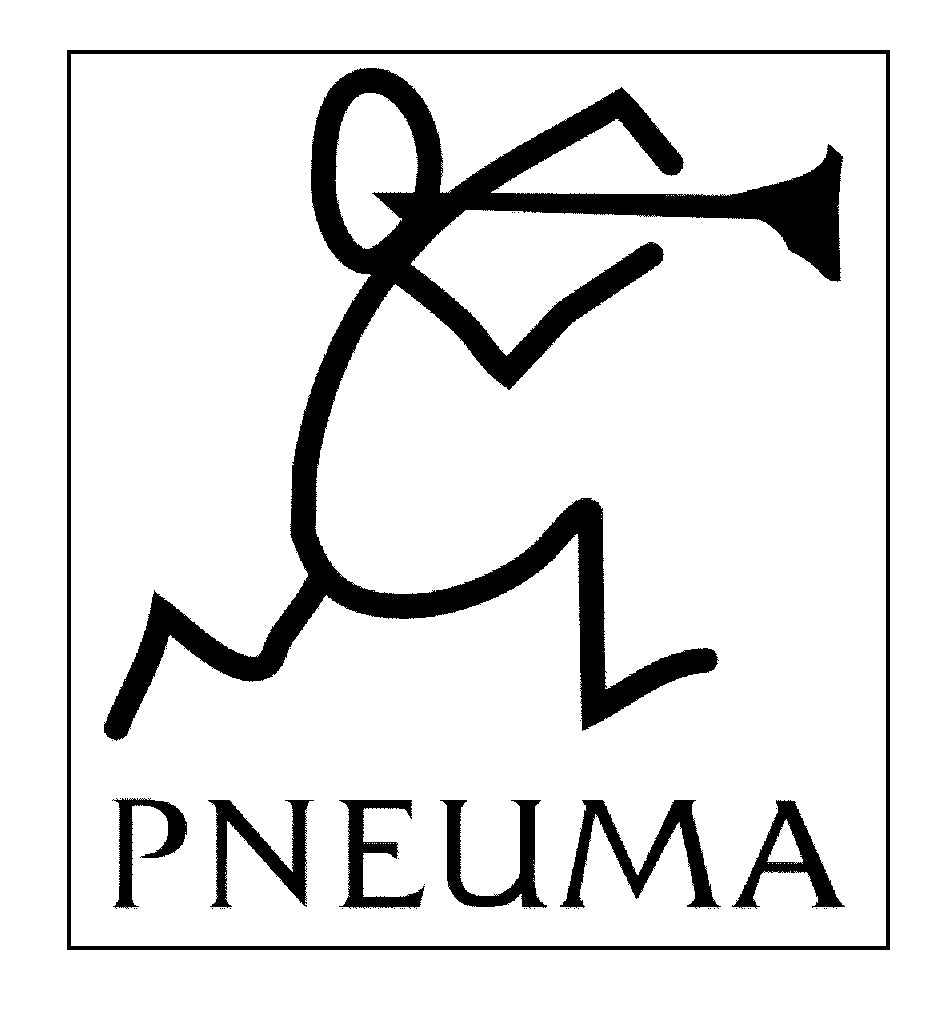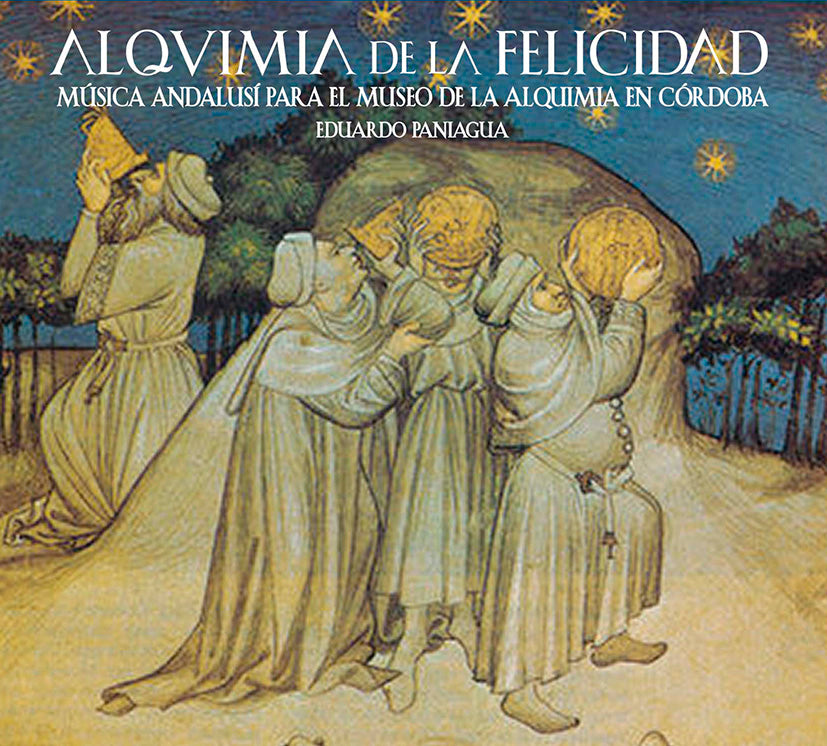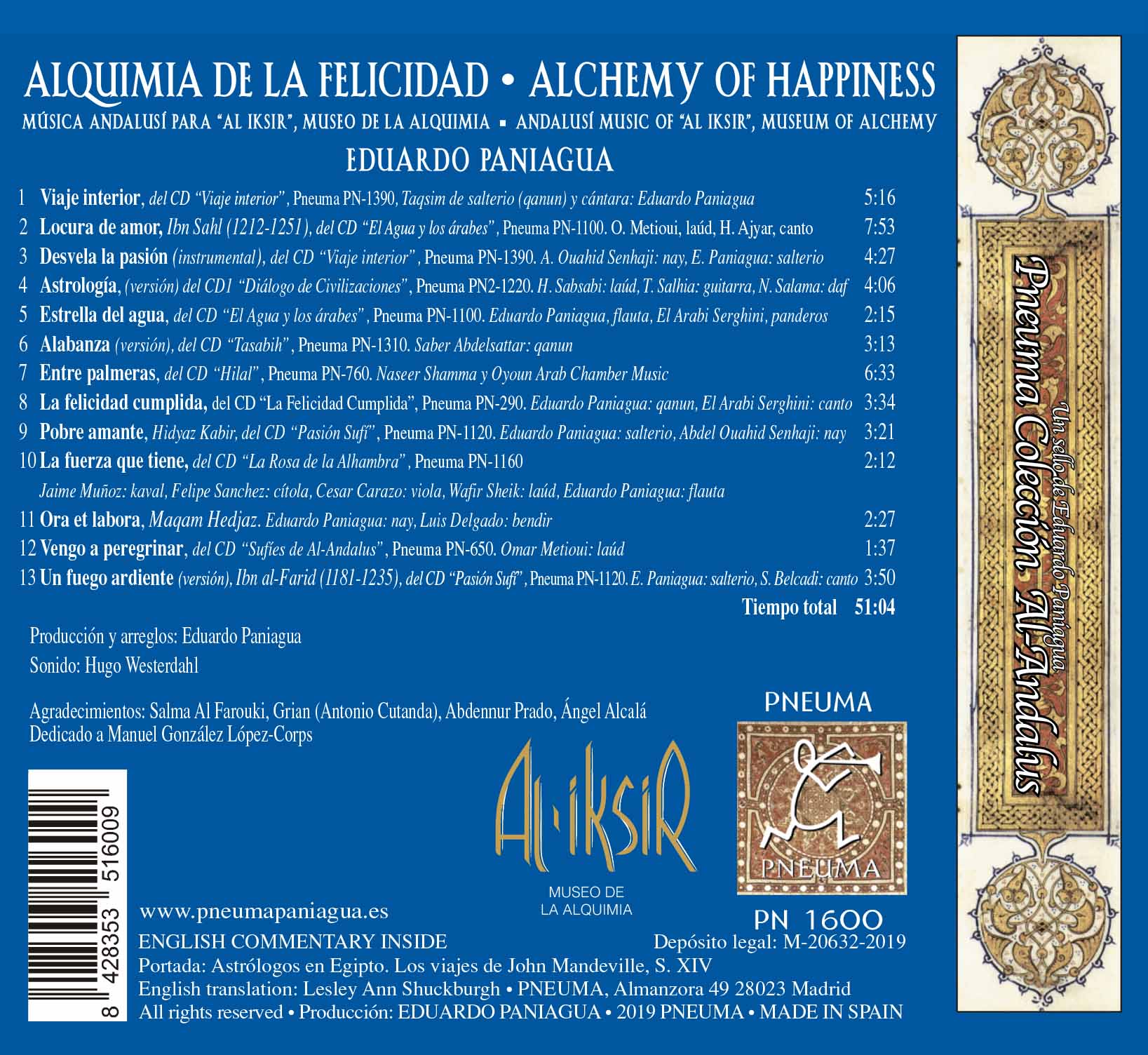pneumamusic
PN 1600 ALQUIMIA DE LA FELICIDAD
PN 1600 ALQUIMIA DE LA FELICIDAD
No se pudo cargar la disponibilidad de retiro
Índice
Índice
ALQUIMIA DE LA FELICIDAD
EDUARDO PANIAGUA
Música andalusí para Al Iksir, el Museo de la Alquimia en Córdoba
PN-1600
Al Iksir, el Museo de la Alquimia en Córdoba
Desde hace 30 años Córdoba tiene la suerte de contar con la labor de Salma Al Farouki, que por entonces comenzó un proyecto de recuperación y conservación de la memoria andalusí en la Torre de la Calahorra, continuando después su trabajo con creaciones como la Casa Andalusí. En octubre de 2017 inauguraba en un espacio contiguo Al Iksir, el primer Museo de la Alquimia en nuestro país, situado en la Calle Judíos, nº14 de Córdoba.
Salma desea especialmente que las nuevas generaciones sepan de esta ciencia que explica el desarrollo de la ciudad. Dar a conocer la historia de la alquimia y contribuir a la divulgación de una disciplina que aún sigue viva.
VIAJE INTERIOR. Bienvenidos a “Alquimia de la Felicidad”, música para el Museo de la Alquimia de Córdoba. Entran ustedes en un espacio sonoro que invita a la meditación y al trabajo.
La alquimia, el arte milenario de la transmutación de la materia, es también un arte de la transformación espiritual. El alquimista pasa por las mismas fases que la materia prima sobre la que opera. Su objetivo es extraer de ella, y de sí mismo, la quintaesencia, el éter, el extracto más puro y concentrado.
El oro como símbolo de la iluminación, la piedra filosofal, el secreto de la alquimia capaz de transmutar el mundo material, el elixir de la vida, remedio para las enfermedades del alma y vía para la inmortalidad. La trasmutación para devolver al hombre a su estado de pureza y perfección original.
El museo y esta música que le acompaña, no pretenden desvelar los secretos de la alquimia, sino ser una puerta abierta a este mundo fascinante, pues también tú puedes ser un alquimista. Puerta a un mundo sellado por el arcano del secreto, pues no hay palabras que sustituyan al verdadero trabajo en el interior de la persona o en el laboratorio.
1 Viaje interior, del CD “Viaje interior”, Pneuma PN-1390 5:16
Taqsim de salterio (qanun) y cántara: Eduardo Paniagua
ALQUIMISTAS. La alquimia tiene una larga historia. No es una mera precursora de la química moderna, sino un arte milenario desarrollado por destacadas personalidades de la antigüedad desde Mesopotamia, Egipto, China, Grecia, y singularmente por la civilización árabo-musulmana Al-Andalus en especial, y en Europa desde el siglo XII hasta el presente. Pitágoras acuño el concepto de medicina del alma y los misterios del Arte Real. La alquimia verde de la medicina y la astronomía. La medicina para los males del cuerpo, la sabiduría para los del alma.
2 Locura de amor, Ibn Sahl (1212-1251), del CD “El Agua y los árabes”, Pneuma PN-1100 7:53
Omar Metioui, laúd, Hasan Ajyar, canto
Soy quien siente esta locura de amor, te amo, luna, por encima de todos.
LÁMPARA. En al-Andalus, este arte se entrelaza con el conocimiento de los nombres de Dios, la numerología, la aroma-terapia y la astrología.
3 Desvela la pasión (versión instrumental), del CD “Viaje interior”, Pneuma PN-1390 4:42
Abdel Ouahid Senhaji: nay, Eduardo Paniagua: salterio
ASTROLOGÍA . Astrólogos y alquimistas creen que los astros tienen un poderoso influjo sobre el mundo natural y por tanto afectan sobre el preparado de las transmutaciones. Cada metal se encuentra bajo el influjo de un cuerpo celeste; por ejemplo, el hierro con Marte, la plata con la Luna, el oro con el Sol, etc.
La palabra astrolabio procede del griego y significa «buscador de estrellas». El alquimista se sabe conectado con los astros, a cuyo influjo se hace receptivo y cuya posición debe conocer a la hora de realizar sus operaciones.
4 Astrólogos, (versión) del CD1 “Diálogo de Civilizaciones”, Pneuma PN2-1220 5:00
Hussein Sabsabi: laúd, Tarek Salhia: guitarra, Nasser Salama: percusión
YABIR. Destacamos en el siglo VIII al persa Abu Mūsa Ŷābir ibn Hayyan (725-815), conocido como Geber y apodado “el padre de la alquimia”. Introdujo la metodología científica y la experimentación en el laboratorio. Sus obras tratan de la purificación de los metales, de la fabricación del acero, del tinte de textiles y cueros, de barnices resistentes al agua, del uso del dióxido de manganeso en la fabricación del vidrio. Inventó instrumentos de laboratorio y se le atribuyen la síntesis de sustancias como los ácidos sulfúrico, cítrico, tartárico, acético, nítrico y clorhídrico. Mezclando estos dos últimos ácidos produjo el aqua regia, capaz de alterar el oro.
5 Estrella del agua, del CD “El Agua y los árabes” Pneuma PN-1100 2:16
Eduardo Paniagua, flauta, El Arabi Serghini, panderos
VITRINAS. Los alquimistas desarrollaron diversas técnicas, tales como la filtración y la destilación. Crearon nuevas aleaciones, descubrieron elementos desconocidos hasta entonces.
6 Alabanza (versión), del CD “Tasabih”, Pneuma PN-1310 3:13
Saber Abdelsattar: qanun
ARBOL DE LA VIDA. El árbol de la vida, de la sabiduría del paraíso terrenal y del cosmos, es una metáfora del vínculo entre los cuatro elementos: tierra, agua, fuego y aire. Hunde sus raíces en la tierra para absorber los minerales disueltos por el agua y eleva sus hojas en el aire para recibir la energía de la luz y del sol. Puente entre el cielo y la tierra, el árbol tiene una doble corriente energética que asciende de la tierra al cielo y que desciende en sentido contrario.
7 Entre palmeras, del CD “Hilal”, Pneuma PN-760 6:34
Naseer Shamma y Oyoun Arab Chamber Music
ELEMENTOS. La alquimia es inseparable de la física de los cuatro elementos. La obra de la naturaleza es una sucesión de disoluciones y de cristalizaciones sometidas al ciclo de la vida: nacimiento, vida, muerte, resurrección. Destrucción y nueva creación, disolución y nueva coagulación. Así procede el alquimista: disuelve las imperfecciones de su alma y las hace cristalizar de nuevo en una forma más noble, pero solo si está en armonía con Dios y su obra, la naturaleza.
8 La felicidad cumplida, del CD “La Felicidad Cumplida”, Pneuma PN-290 3:34
El Arabi Serghini: Canto, Eduardo Paniagua: qanun
LABORATORIO. Es necesario el laboratorio con el horno de calcinación, la tabla esmeralda de Hermes Trismegisto (Enoc, bisabuelo de Noé), los aceites esenciales, una biblioteca de aromas, así como destiladores, retortas y matraces. No es esta una ciencia improvisada, este camino lo han recorrido anónimamente generaciones de alquimistas en busca del secreto de la transmutación.
Preceptos de Hermes Trismegisto, la Tabla de Esmeralda:
I. Lo que digo no es ficticio, sino digno de crédito y cierto.
II. Lo que está más abajo es como lo que está arriba, y lo que está arriba es como lo que está abajo. Actúan para cumplir los prodigios del Uno.
III. Como todas las cosas fueron creadas por la Palabra del Ser, así todas las cosas fueron creadas a imagen del Uno.
IV. Su padre es el Sol y su madre la Luna. El Viento lo lleva en su vientre. Su nodriza es la Tierra.
V. Es el padre de la Perfección en el mundo entero.
VI. Su poder es fuerte si se transforma en Tierra.
VII. Separa la Tierra del Fuego, lo sutil de lo burdo, pero sé prudente y circunspecto cuando lo hagas.
VIII. Usa tu mente por completo y sube de la Tierra al Cielo, y, luego, nuevamente desciende a la Tierra y combina los poderes de lo que está arriba y lo que está abajo. Así ganarás gloria en el mundo entero, y la oscuridad saldrá de ti de una vez.
IX. Esto tiene más virtud que la Virtud misma, porque controla todas las cosas sutiles y penetra en todas las cosas sólidas.
X. Éste es el modo en que el mundo fue creado.
XI. Éste es el origen de los prodigios que se hallan aquí.
XII. Esto es por lo que soy llamado Hermes Trismegisto, porque poseo las tres partes de la filosofía cósmica.
XIII. Lo que tuve que decir sobre el funcionamiento del Sol ha concluido.
9 Pobre amante, Hidyaz Kabir, del CD “Pasión Sufí”, Pneuma PN-1120 3:21
Eduardo Paniagua: salterio, Abdel Ouahid Senhaji: nay
ROTA. La rota o rueda cíclica del cosmos se organiza en tres círculos concéntricos: el círculo exterior se relaciona con las 12 puertas del zodiaco, el círculo intermedio ordenado en 28 sectores o moradas lunares y el círculo interior es el de las luminarias. Desde el centro del círculo el sabio puede ordenar el mundo cambiando el punto de vista de su mirada y atraer así las diferentes fuerzas del universo.
10 La fuerza que tiene, Maluf, del CD “La Rosa de la Alhambra”, Pneuma PN-1160 2:12
Jaime Muñoz: kaval, Felipe Sanchez: cítola, Cesar Carazo: viola, Wafir Sheik: laúd, Eduardo Paniagua: flauta
ESCALERAS. La máxima de los sabios alquimistas: Ora et Labora, la oración y el trabajo, inicia la transformación de la materia y del espíritu. El silencio, la armonía y la ordenación de tu consciencia. Aquí encontrarás comentarios a los magisterios espagíricos. Pero recuerda, este es lugar de silencio, oración y trabajo.
11 Ora et labora, Maqam Hedjaz
Eduardo Paniagua: nay, Luis Delgado: bendir
PAREJA ALQUÍMICA . Los alquimistas han desarrollado el conocimiento con una rica y compleja iconografía mediante símbolos y figuras. Un símbolo recurrente es el de la pareja alquímica. Un hombre y una mujer que, de modo natural, representan los dos polos de la obra: el azufre y el mercurio. El calor y la sequedad corresponden al azufre, y el frío y la humedad al mercurio. Estos dos polos pueden, mediante un amor sublimado por la espiritualidad, desencadenar el poder que provoca primero la disolución y después la cristalización: solve et coagula (apotegma alquímico), muerte del hombre viejo y nacimiento del hombre nuevo. De su perfecta unión se obtiene el oro vivo, el metal más noble, símbolo del estado de inocencia original del alma.
12 Vengo a peregrinar, del CD “Sufíes de Al-Andalus”, Pneuma PN-650 1:38
Omar Metioui: laúd
COMBUSTIÓN. Recorre estas estancias, esta música, en silencio interno. Este es lugar de oración y trabajo.
13 Un fuego ardiente, Ibn al-Farid (1181-1235), del CD Pasión Sufí”, Pneuma PN-1120 6:22
Eduardo Paniagua: salterio y fuego, Said Belcadi: canto
No me consideréis artificioso en mi pasión. Mi afección por vosotros es natural, sin hipocresía.
Es que mi espíritu está en mi mano, y lo he entregado a aquel que me anuncia vuestra llegada.
Alquimia de la Felicidad, Al Ghazali (Algacel) 1057-1111
Al Iksir, el Museo de la Alquimia
C/ Judíos 14, 14004 Córdoba
phone +34 957 890 598
www.museodelaalquimia.com
museoalquimia@gmail.com
Descripción
Descripción
Alchemy of Happiness
EDUARDO PANIAGUA
Andalusí music of Al Iksir, Museum of Alchemy, Córdoba
Al Iksir, the Museum of Alchemy in Córdoba
Cordoba has been fortunate enough to benefit from the work of Salma Al Farouki for the last 30 years. He started by focusing on a project to recover and preserve the memory of Al-Andalus (Muslim Spain) in the Calahorra Tower, later continuing his work with creations such as the Casa Andalusí. In October 2017 Al Iksir, the first Museum of Alchemy in our country, was opened in a space adjacent to the tower at No. 14 Calle Judíos in Córdoba.
Salma would especially like future generations to learn about the science that has been so important for the development of the city, by teaching the history of alchemy and by spreading an awareness of a discipline that is still alive today.
INNER JOURNEY
Welcome to ""Alchemy of Happiness"", music for Córdoba’s Museum of Alchemy. You are entering a sound space conducive to meditation and work.
Alchemy, the ancient art of the transmutation of matter, is also an art of spiritual transformation. The alchemist experiences the same stages as the raw material he works with, endeavouring to extract the quintessence, the ether, the purest, and most concentrated extract from it and from himself.
Gold, a symbol of enlightenment, the philosopher's stone, the secret of alchemy, able to transmute the material world, the elixir of life, a remedy for the ills of the soul and the path to immortality. Transmutation: returning man to his original state of purity and perfection.
The museum and this music that accompanies it, do not intend to unveil the secrets of alchemy, but to open a door to this fascinating world where you too can be an alchemist. A door to a world sealed by arcane secrets, since no words can replace the true work inside the person or in the laboratory.
1 Viaje interior (Inner journey), from the CD Viaje interior, Pneuma PN-1390 5:16
Taqsim played on a psaltery (qanun) and clay pot: Eduardo Paniagua
ALCHEMISTS
Alchemy has a long history. It is not merely a forerunner of modern chemistry, but an art that goes back thousands of years, developed by the leading figures of antiquity from Mesopotamia, Egypt, China, and Greece, and especially the Arab-Muslim civilisation of Al-Andalus. It has been practised in Europe since the 12th century to the present day. Pythagoras coined the concept of medicine of the soul and the mysteries of the Royal Art. The green alchemy of medicine and astronomy. Medicine for the ills of the body, wisdom for the ills of the soul.
2 Locura de amor (Madness of love), Ibn Sahl (1212-1251), from the CD El Agua y los Árabes, Pneuma PN-1100 7:53
Omar Metioui, lute, Hasan Ajyar, voice
I am the one who feels this madness of love, I love you, Moon, above all.
LAMP
In Al-Andalus, this art is intertwined with the knowledge of the Names of God, numerology, aromatherapy, and astrology.
3 Desvela la pasión (Unveiling passion) (instrumental version), from the CD Viaje Interior, Pneuma PN-1390 4:42
Abdel Ouahid Senhaji: nay, Eduardo Paniagua: psaltery
ASTROLOGY
Astrologers and alchemists believe that the stars have a powerful influence on the natural world and therefore affect the preparation of the transmutations. Each metal is under the influence of a celestial body - for example, iron under Mars, silver under the Moon, gold under the Sun, and so on.
The word astrolabe comes from Greek and means ""star seeker"". The alchemist knows he is connected to the celestial bodies; he is receptive to their influence and must know their position when performing his art.
4 Astrólogos (Astrologers), (version) from CD1 Diálogo de Civilizaciones, Pneuma PN2-1220 5:00
Hussein Sabsabi: lute, Tarek Salhia: guitar, Nasser Salama: percussion
YABIR
In the 8th century, the Persian Abu Mūsa Ŷābir ibn Hayyan (725-815), known as Geber and nicknamed ""the father of Alchemy” brought scientific methodology and experimentation to the laboratory. His works deal with the purification of metals, steel manufacture, textile and leather dyes, water-resistant varnish, and the use of manganese dioxide in glass manufacture. He invented laboratory instruments and is credited with the synthesis of substances such as sulphuric, citric, tartaric and acetic acids, as well as nitric and hydrochloric acids which when mixed produced aqua regia, capable of altering gold.
5 Estrella del agua (Star of the water), from the CD El Agua y los árabes 10 Pneuma PN-1100 2:16
Eduardo Paniagua, recorder, El Arabi Serghini, tambourines
DISPLAY CABINETS
Alchemists developed various techniques, such as filtration and distillation. They created new alloys and discovered previously unknown elements.
6 Alabanza (Praise) (version), from the CD Tasabih, Pneuma PN-1310 3:13
Saber Abdelsattar: qanun
TREE OF LIFE
The tree of life, the wisdom of paradise on earth and of the cosmos, is a metaphor for the link between the four elements: earth, water, fire and air. It sinks its roots into the soil to absorb the minerals dissolved by water and raises its leaves in the air to receive energy from light and the sun. A bridge between heaven and earth, the tree has a double stream of energy that ascends from earth to heaven and descends in the opposite direction.
7 Entre palmeras (Among palm trees), from the CD Hila, Pneuma PN-760 6:34
Naseer Shamma and Oyoun Arab Chamber Music
ELEMENTS
Alchemy is inseparable from the physics of the four elements. Nature’s work is a succession of solutions and crystallizations in the cycle of life: birth, life, death, and resurrection. Destruction and new creation, dissolution and new coagulation. This is how the alchemist works: dissolving the imperfections of his soul and making them crystallize in a more noble form, but only if in harmony with God and His work: Nature.
8 La felicidad cumplida (Prefect bliss), from the CD La Felicidad Cumplida, Pneuma PN-290 3:34
El Arabi Serghini: voice, Eduardo Paniagua: qanun
LABORATORY
The laboratory is essential, with the calcination furnace, the Emerald Tablet of Hermes Trismegistus, (Enoch, Noah’s great grandfather), essential oils, a library of aromas and distillers, retorts and flasks. This is not an improvised science; generations of alchemists have anonymously trodden this path in search of the secret of transmutation.
The precepts of Hermes Trismegistus, the Emerald Tablet:
1) It is true without untruth, certain and most true
2) That which is below is like that which is above and that which is above is like that which is below to do the miracles of One only.
3) And as all things are, and come from One, by the mediation of One, so all things are born from this unique thing by adaptation.
4) The Sun is the father and the Moon the mother. The wind carries it in its stomach. The Earth is its nurse.
5) The father of all perfection in the whole world is here.
6) Its force, or power, remains entire if it is converted into Earth
7) You separate the Earth from the fire, the subtle from the gross, gently with great industry.
8) It climbs from the Earth and descends from the sky and receives the force of things superior and things inferior. By this means, you shall have the glory of the whole world and all obscurity will flee from you.
9) Its force is above all force, for it vanquishes every subtle thing and penetrates every solid thing.
10) So was the world created.
11) From it are born wonderful adaptations, of which the way here is given.
12) That is why I have been called Hermes Trismegistus, having the three parts of the universal philosophy.
13) Herein have I completely explained the Operation of the Sun.
9 Pobre amante (Poor lover), Hidyaz Kabir, from the CD Pasión Sufí, Pneuma PN-1120 3:21
Eduardo Paniagua: psaltery, Abdel Ouahid Senhaji: nay
WHEEL
The wheel, or cosmic wheel, is arranged in three concentric circles: the outer circle relates to the 12 gates of the zodiac, the middle circle is divided into 28 sectors or lunar mansions and the inner circle corresponds to the luminaries. The wise man can bring order to the world from the centre of the circle, by changing the direction of his gaze and thus attracting different forces of the universe.
10 La fuerza que tiene (Her strength), Ma'luf, from the CD La Rosa de la Alhambra, Pneuma PN-1160 2:12
Jaime Muñoz: kaval, Felipe Sánchez: citole, César Carazo: viola, Wafir Sheik: lute, Eduardo Paniagua: recorder
STAIRS
The transformation of matter and of the spirit begins with the maxim of the learned alchemists: Ora et Labora, prayer and work. The silence, harmony and ordering of the conscience. Here you will find commentaries on the spagyric magisteries. But remember, this is a place of silence, prayer and work.
11 Ora et labora, Maqam Hedjaz
Eduardo Paniagua: nay, Luis Delgado: bendir
THE ALCHEMICAL COUPLE
Alchemists developed their knowledge with a rich and complex iconography of symbols and figures. A recurring symbol is the alchemical couple. A man and a woman who naturally represent the two poles: sulphur and mercury. Sulphur is hot and dry while mercury is cold and moist. These two poles can unleash the power that first causes dissolution and then crystallization, through love sublimated into spirituality: Solve et Coagula (alchemical aphorism), the death of the old man and the birth of the new man. Living gold is obtained from its perfect union, the noblest metal, symbol of the soul’s original state of innocence.
12 Vengo a peregrinar (I come on a pilgrimage), from the CD Sufíes de Al-Andalus, Pneuma PN-650 1:38
Omar Metioui: lute
COMBUSTION
Enjoy these rooms, this music, in inner silence. This is a place of prayer and work.
13 Un fuego ardiente (A burning fire), Ibn al-Farid (1181-1235), from the CD Pasión Sufi, Pneuma PN-1120 6:22
Eduardo Paniagua: psaltery and fire, Said Belcadi: voice
Do not consider me artificial in my passion. My affection for you is natural, without hypocrisy.
My spirit is in my hand, and I have given it to he who announces your arrival to me.
You are my religious obligation and my devotion.
You are my word and my work, you are the direction in which I prostrate myself when I carry out my prayer.
Your beauty is what my eye contemplates: my whole being has turned towards it.
Your secret is in my conscience and my heart is the mountain where God manifested Himself.
I noticed a fire in the neighbourhood and I announced it, joyfully, to my people.
I said to them: ""Stay, and perhaps that way I will find my guide.""
Alchemy of Happiness, Al Ghazali (Algacel) 1057-1111
Al Iksir, the Museum of Alchemy in Córdoba
C/ Judíos 14, 14004 Córdoba
phone +34 957 890 598
www.museodelaalquimia.com
museoalquimia@gmail.com
Compartir
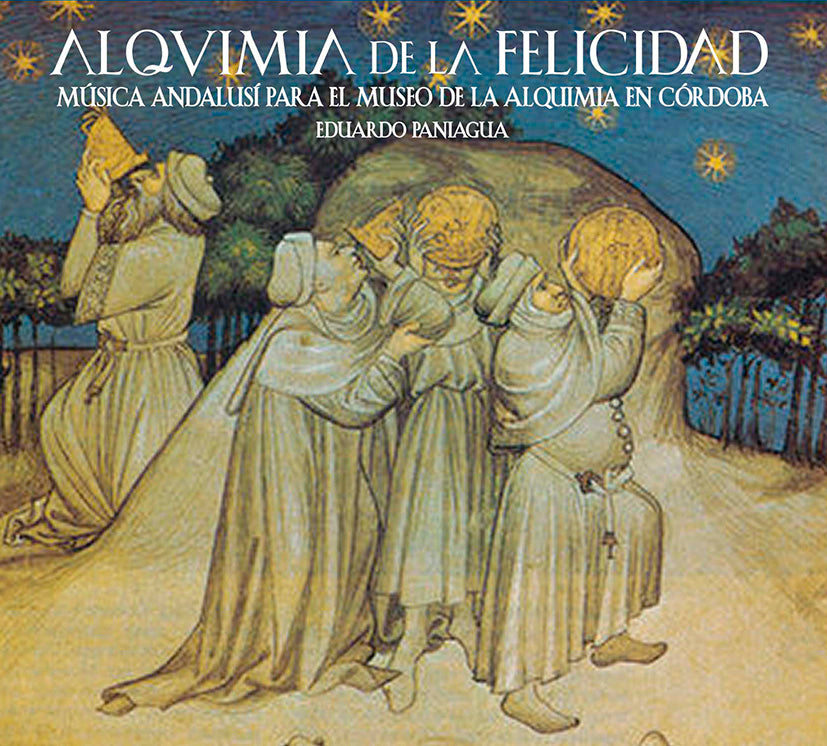
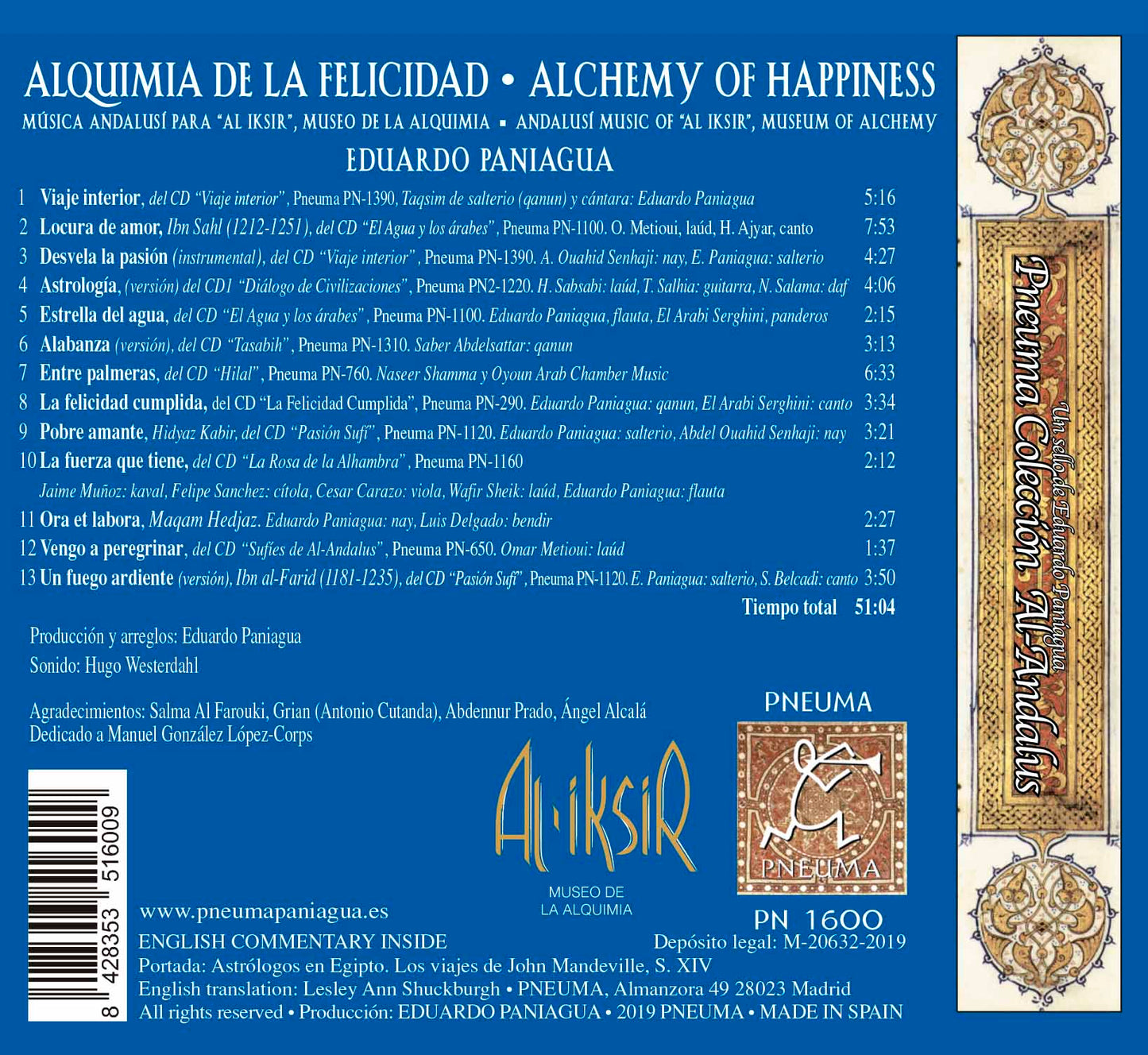
-
Envío gratis en pedidos mayores a 50 €.
Entrega en 5-7 días laborables para pedidos en España, en el caso de envíos fuera de España el tiempo de envío podría ser algo mayor.
-
Todo el trabajo de Pneuma Music se ha realizado en España.
Música medieval española inédita hasta el momento. Sus discos, con formato Digipack de cubierta de cartón y libreto interior (bilingüe + idioma original), quieren acercarse a una obra de arte total.
